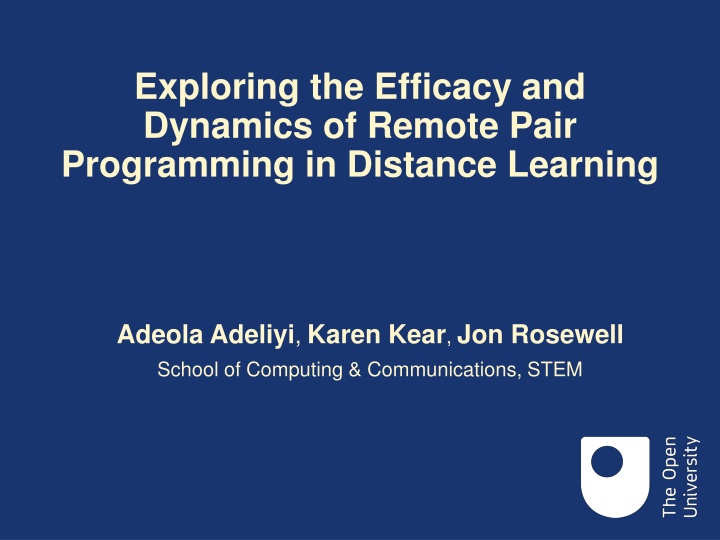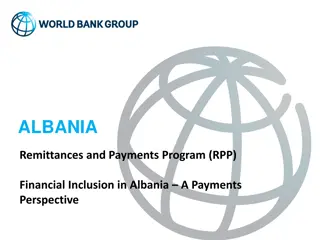
Dynamics of Remote Pair Programming in Distance Learning
Explore the efficacy of remote pair programming in distance learning, focusing on communication tools, pair formation, sessions, feedback, and analysis. Discover how generic collaborative tools can support remote pair programming, creating a conducive environment for student collaboration and skill enhancement.
Download Presentation

Please find below an Image/Link to download the presentation.
The content on the website is provided AS IS for your information and personal use only. It may not be sold, licensed, or shared on other websites without obtaining consent from the author. If you encounter any issues during the download, it is possible that the publisher has removed the file from their server.
You are allowed to download the files provided on this website for personal or commercial use, subject to the condition that they are used lawfully. All files are the property of their respective owners.
The content on the website is provided AS IS for your information and personal use only. It may not be sold, licensed, or shared on other websites without obtaining consent from the author.
E N D
Presentation Transcript
Exploring the Efficacy and Dynamics of Remote Pair Programming in Distance Learning Adeola Adeliyi, Karen Kear, Jon Rosewell School of Computing & Communications, STEM
Background Pair Programming Pair Programming (PP) is widely used in agile software development. A developer in the driver role writes the code, and controls the keyboard and mouse; the other developer, the navigator, watches for potential defects and assists with design decisions as the code is being written. These roles are switched often as the development progresses. Using PP in education has been advocated for many years and there has been efforts and eSTEeM projects geared towards its remote implementation at the Open University. Hughes, J., Walshe, A., Law, B. and Murphy, B. (2021) Investigating the Perceived Benefits to Computing Students of Remote Pair Programming. eSTEeM Final Report Our Project This project delved into direct participation of students in remote pair programming (RPP) over a 4 or more sessions. We examined the efficacy of generic communication tools for RPP, the speed at which pairs become jelled (learned to function well together), the impact of interaction methods and prior experience, and students' overall perception of RPP. While student participation is passive, results suggest that remote collaboration students' verbal communication and teamwork skills, enhancing problem-solving, initiative-taking abilities, with a slight increase in learning from peers. significantly bolstered decision-making, and 2
Methodology Stage 1: Selection of Tools Identification of available generic collaborative tools capable of supporting RPP. Initial assessment of the tools based on functionality and user-friendliness, disregarding the absence of advanced features found in bespoke tools. Stage 2: Introduction & Pair Formation First Session: Researcher-facilitated ice-breaking meeting to explain pair programming principles, addressing student queries and introducing assigned partners. Subsequent Sessions: Pairs autonomously managed the sessions, deciding on the schedule, activities, and initial drivers. Stage 3: RPP Sessions Students engaged in RPP sessions utilizing the chosen tool(s). Recording of sessions for further analysis and observation. Stage 4: Feedback & Reflection Students maintained a reflective journal after each session, noting their experiences and evaluations of the collaboration tools and dynamics. Guidance provided through prompts such as What was good/bad? , Did you work well with your partner? , etc. Closure with a questionnaire to gather comprehensive feedback, incentivized with vouchers. Stage 5: Studies and Analysis Conducted two separate studies investigating different dimensions to identify variables influencing RPP. Focus areas included analysis of collaborative tools, pairing methods, and dynamics of pair jelling. 3
What tools support RPP? Most RPP studies involve custom tools like IDE Plugins created by researchers, which are often prototypes and hard to acquire. Our first research question therefore is Can some generic collaborative tools be adopted for RPP? These tools must support this three broad categories: Screen Sharing | Remote desktop control | Integrated communications Audio-Visual Communication Whiteboard & Annotations Mouse Cursor Control Ease of swapping Roles Tool AdobeConnect x x GoToAssist x x x Stride x Skype x x TeamViewer x x x USETogether (Drovio) x x x x Zoom x x x Microsoft Teams x x x x Kindly note that this information is based on the features available in the tools as of June 2019. 4
How long for a pair to jel? "Pair jelling," the process where programmers transition from working alone to collaborating. As distance learning students often have limited interactions with their peers, it could lead to longer jelling and in turn less engagement with RPP. Our research aims to determine the duration of this jelling phase and analyse how different 'leadership styles,' as described by Kaur Kuttal et al., influence role-swapping and collaboration dynamics. Democratic style (shares the decisions with the other partner) Authoritative style (dominates the interactions) Laissez-faire style (all decision-making is delegated to the other partner) Paternalistic style (instructs the other partner) 5
Are RPP Benefits significant to Students? Remote Pair Programming (RPP) certainly comes with its own set of demands and challenges. There is a necessary investment of time and effort in learning new tools and technologies, scheduling sessions, preparing for the sessions etc which could potentially be seen as an overhead by students. We are keen to explore whether students, who are primarily involved in a independent learning is the norm, still perceive and embrace the collaborative aspects positively. This insight will shed light on the adaptability of RPP methodologies in environments where individual learning is predominantly favoured. self-study context where 6
Analysis & Results Using Collaboration Tools We analysed the students' feedback using both qualitative insights from their reflective journals and quantitative as well as qualitative data from the final survey. The survey responses, measured on a Likert scale ranging from 1 to 5, were evaluated using median values to indicate central tendencies and the interquartile range (IQR) to denote response dispersion. The results highlight consensus (IQR < 2) on positive (median 4) or negative (median 2) perceptions of the statements provided. Text boxes in the survey allowed for detailed student responses. Most USETogether(Drovio) and Microsoft Teams user-friendly satisfactory audio-visual Teams offered functions compared to USETogether, which is specifically designed for RPP. Despite varied experiences system stability feedback hints at the potential viability of generic collaboration tools like Teams for RPP, though the limited responses restrict conclusive remarks. students found and with quality. recording better with initial (IQR=2), 7
Analysis & Results Pair jelling period & leadership style The observed interaction styles and the skill levels reported in the pre-study questionnaire were analysed to evaluate their influence on pair jelling. The end of study survey asked about the students' perceived duration to achieve jelling, with the responses corroborating the observations made during the online sessions, as delineated in the final column table. Gender Leadership Style Skills Level Sessions before jelling Pair P1 P2 P1 P2 P1 P2 Male Male Democratic Authoritative Novice Intermediate 2 Alpha Male Male Democratic Authoritative Novice Novice 3 Beta Male Male Democratic Democratic Intermediate Novice 1 Delta Female Female Democratic Democratic Novice Novice 1 Epsilon Male Female Democratic Paternalistic Advanced Novice 2 Gamma The data implies that pairs with homogeneous styles tend to jel quickest. Despite literature suggesting a preference for collaborating with equal skill levels, the study found that the alignment of leadership styles had a more significant impact on the speed of jelling (Beta and Epsilon Group). In the observed cases, pair interaction styles remained constant until jelling occurred, after which a more adaptive and fluid dynamic was noted. It is highlighted that while remote teams can establish trust quickly, this trust is fragile and crucial to the success of the collaboration. 8
Analysis & Results Benefits Given the extensive research highlighting the advantages of pair programming (PP) for students in co-located settings, we incorporated four statements in the final survey to evaluate its potential benefits in the context of their learning experience. Student impact Study 1 (n= 10) Study 2 (n = 24) MED IQR MED IQR My coding and debugging skills are better than before I used pair programming 4.5 1 4 1 Participating in RPP has improved my confidence level when communicating my thought process My RPP sessions helped improve my time management skills 5 1 4 1.5 4 1 3 2 My study habits were positively affected because of the RPP sessions 4.5 3 3.5 1.5 The majority of students concurred or emphatically agreed that remote pair programming (RPP) enhanced their learning experience. An anomaly was noted in the groups from Study 2, where the consensus regarding the influence on time management skills was more neutral. This discrepancy can be attributed to the pairing methodology; while Study 1 groups were paired based on their available time slots, Study 2 groups were paired randomly without considering time availability. This was evident in their scheduling struggles, as participants found it challenging to coordinate mutually convenient times. 9
Analysis & Results Benefits Improved feeling of inclusion and social interaction Improved team working experience, e.g. confidence in communication, motivation, skill for employment A positive impact from peer pressure, e.g. keep up with studies before sessions, time management and discipline. Improved coding skills from learning from pair, i.e. knowledge transfer. My coding skills have definitely improved, but also my understanding of how to code and what you can and shouldn't do. It was also really nice to have someone else to talk to who is studying the same module as me. Distant learning can get very lonely and this has massively helped alleviate this feeling I am very satisfied with the experience because I feel it brought to light the best part of me in a programming context. I always felt problem- solving includes creativity and ideas come much easier when I can bounce them with a partner, our minds are more agile and personally, I felt empowered to know I am not alone in solving it. 10
Conclusion In conclusion, incorporating RPP into distance learning computing modules holds promise, fostering improved learning experiences in distance education. However, successful implementation hinges on addressing potential obstacles, such as offering guidance on optimal use of existing communication tools, considering time availability and leadership styles in student pairing, and selecting appropriate exercises conducive to pair programming. This approach promises to elevate the learning experience in distance education. 11
Thank you! Contact details: Adeola Adeliyi adeola.adeliyi@open.ac.uk 12

